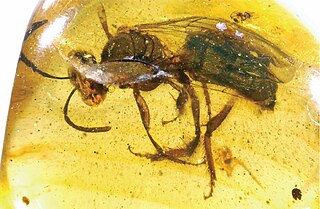
Halictidae is the second-largest family of Anthophila bees. Halictid species occur all over the world and are usually dark-colored and often metallic in appearance. Several species are all or partly green and a few are red; a number of them have yellow markings, especially the males, which commonly have yellow faces, a pattern widespread among the various families of bees. The family is distinguished by the arcuate basal vein found on the wing.
Sweat bee is a common name for various bees that are attracted to the salt in human sweat. It can refer to:

In biology, Lipotriches is a large genus of sweat bees in the family Halictidae, distributed widely throughout the Eastern Hemisphere though absent from Europe. There are nearly 200 species in 9 subgenera. They commonly have prominent bands of hair on the margins of the metasomal segments.

Oligochlora is an extinct genus of sweat bee in the Halictidae subfamily Halictinae. The genus currently contains six species, all of which are known from the early Miocene Burdigalian stage Dominican amber deposits on the island of Hispaniola.
Augochlora leptoloba is a species of sweat bee in the genus Augochlora and the extinct monotypic subgenus Electraugochlora.
Lipotriches notiomorpha is a species of bee in the genus Lipotriches, of the family Halictidae. It is endemic to Sri Lanka, where it was first found from Anuradhapura district.
Lipotriches krombeini is a species of bee in the genus Lipotriches, of the family Halictidae.
Lipotriches basipicta is a species of bee in the family Halictidae.
Lipotriches bombayensis is a species of bee in the genus Lipotriches, of the family Halictidae.
Lipotriches torrida is a species of bee in the genus Lipotriches, of the family Halictidae.
Lipotriches exagens is a species of bee in the genus Lipotriches, of the family Halictidae.
Lipotriches fervida is a species of bee in the genus Lipotriches, of the family Halictidae.
Lipotriches fulvinerva is a species of bee in the genus Lipotriches, of the family Halictidae.
Lipotriches edirisinghei is a species of bee in the genus Lipotriches, of the family Halictidae.
Lipotriches karnatakaensis is a species of bee in the genus Lipotriches, of the family Halictidae.

Nomia is a cosmopolitan genus of sweat bees in the family Halictidae. Many species have opalescent bands on the metasoma. Nomia species are moderate-sized bees that nest in the ground. Most species nest solitarily, but some species also nest communally where females share a nest but where there are no queen or worker castes. Nomia species are found Africa, tropical Asia, Australia, and in North America. There are about 130 species world wide.
Lipotriches rustica is a species of bee in the genus Lipotriches, of the family Halictidae.

Nomiinae is a subfamily of sweat bees in the family Halictidae. There are about 11 genera and at least 550 described species in Nomiinae.

Halictus hotoni, the emerald furrow bee, is a species of sweat bee in the family Halictidae native to southern Africa and introduced to Australia. It was described by Joseph Vachal in 1903.





